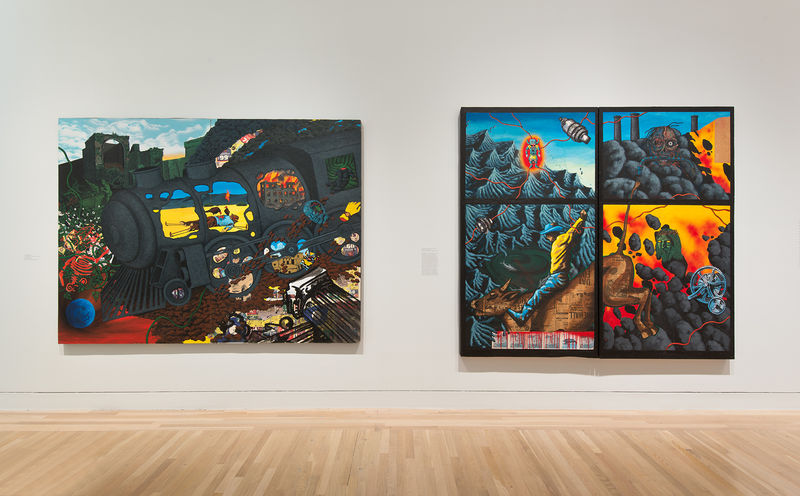
David Wojnarowicz
David Wojnarowicz's biography often provides the framework to situate his provocative and apocalyptic paintings, photomontages, and films of the 1980s. His life experiences—his early history of abuse, hustling, and drugs; his queerness; and his and his friends' fatal struggles with AIDS—furnish the conditions of his artistic production. "I wake up every morning in this killing machine called America," Wojnarowicz wrote, "and I'm carrying this rage like a blood filled egg."# Identifying with the outsiders of the decrepit piers and underground East Village sites that he frequented, Wojnarowicz collided the personal and the social to attack the dominant paradigms of a nation in the throes of the culture wars.
Creating works in numerous mediums—painting, sculpture, collage, photography, and video—Wojnarowicz was also a published writer, musician, and dedicated activist. His saturated, multimedia paintings merge imagery from pop culture, history, and dreams to assemble distinctive narratives and historical allegories. Crash: The Birth of Language / the Invention of Lies (1986) depicts a massive locomotive (a symbol of the industrialized West) tearing through the ruins of past civilizations, throwing up clods of dirt and body parts, and careening toward a diminutive planet. Iconic vignettes—a man tied down in a desert while being eaten by vultures, a burning building, an adobe structure and kachina figurine, and the opening of a tomb—capture moments of intense transition amid the engine's relentless, destructive forward motion.# Wojnarowicz signals the duplicitousness of such "progress," wherein the birth of language becomes the invention of lies.

As the ravaging HIV/AIDS public health crisis tore on, Wojnarowicz's work became increasingly confrontational. In his essay "Postcards from America: X-Rays from Hell" (1989), written two years after his closest friend and mentor, the artist Peter Hujar, died of AIDS and following the news of his own diagnosis, Wojnarowicz asserts, "My rage is really about the fact that WHEN I WAS TOLD THAT I'D CONTRACTED THIS VIRUS IT DIDN'T TAKE ME LONG TO REALIZE THAT I'D CONTRACTED A DISEASED SOCIETY AS WELL."# Originally written for the publication accompanying the exhibition Witnesses: Against Our Vanishing, curated by Nan Goldin, the essay provoked the chairman of the National Endowment for the Arts, John Frohnmayer, to order that no grant money go toward the important exhibition, which catapulted the essay into the spotlight.# In the face of such violent institutional indifference and silencing, Wojnarowicz championed the public expression of personal experiences and visions because, as he wrote in his memoir, "One of the last frontiers left for radical gesture is in the imagination."# Working across multiple mediums, he employed his ecstatic dreams and feverish hallucinations to chronicle the wreckage of contemporary American society.
—Ruth Erickson


